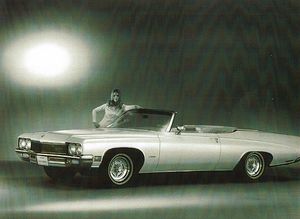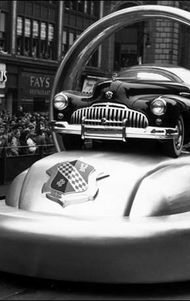.
Buick Centurion

| |
| Buick Centurion | |
|---|---|
| Buick | |
| Production | 1971-1973 |
| Class | Full-Size |
| Body Style | 2-Door Hardtop 2-Door Convertible 4-Door Hardtop |
| Length | |
| Width | |
| Height | |
| Wheelbase | 124" |
| Weight | 3900-4400 lbs |
| Transmission | 3-Speed Automatic |
| Engine | 5.7L (350 cid) V8 (1973) 7.5L (455 cid) V8 (1971-1973) |
| Power | 195-315 hp |
| Similar | Buick LeSabre Chevrolet Caprice/Impala Oldsmobile Delta 88 Pontiac Bonneville/Catalina |
| Platform | B |
The Buick Centurion was introduced in 1971 as a replacement for the Wildcat. The Centurion was based on GM's full-size B-body, which was all-new for 1971 and included the Chevrolet Caprice/Impala, the Oldsmobile Delta 88 and Pontiac's Bonneville/Catalina. The Centurion name was first used on a Buick concept car in the 1956 Motorama. It featured a red and white fiberglass body, airplane like interior design and a full clear "bubble top" roof. The Centurion was unfortunately short-lived and would be dropped after 1973.
Here's a quick rundown:
1971-1973
The Centurion's mission was a basically a LeSabre with some sporty flair added to it, an idea not unlike the previous Mercury Marauder of the 1960's (and of course the previous Wildcat). Naturally the Centurion shared the basic LeSabre's body, but it had some unique styling touches to set it apart from its more-ordinary brethren, such as special badging with a Roman Centurion officer badge on the hood, revised grilles and taillights, which were divided into 6 sections. The Centurion would be available as a 2-door hardtop coupe and sedan, and a convertible - no pillared sedans or wagons would be offered. Full hubcaps were available, but most had Buick's new sporty 5-spoke mag wheels. And unlike the lesser LeSabre, the Centurion's base powerplant was the 315 hp 7.5L (455 cid) 4bbl V8 with either single or dual exhausts. The TH400 3-speed automatic transmission was the only one available. The Centurion also offered a more plush interior than the LeSabre, at times rivaling the more expensive Electra.
For 1972, a new grille and front bumper were added, which flanked the front license plate frame. The taillights were now divided into 12 sections (vs 6 for last year), and the horsepower rating now adopted the net rating vs the gross rating (as did all GM cars this year), resulting in a hp drop to 225. The 455 remained the standard powerplant. For 1973, the Centurion again offered a revised nose which was now nearly identical to the larger Electra, with a smaller grille and new bumper with rubber "bumperettes" that were wider than previous and no longer flanked the front license plate frame, and the taillights were now horizontally divided into 3 sections. New parking lights wrapped around to the sides, doubling as the front side-marker lights. The smaller 195 hp 5.7L (350 cid) 4bbl V8 was now the base powerplant - the 455 was now an extra-cost option, and so-equipped models got special "455" fender badges underneath the Centurion nameplate. The 3-speed automatic transmission was still the only one available (TH350 for the 350, TH400 for the 455). The GM B-bodies would recieve a restyling for 1974, but the Centurion would be dropped after 1973, as sales had started to slide as the public was growing less enthusiatic about sport-oriented full-sized cars.
Total Centurion production was 110,539 units, including 10,296 convertibles.

